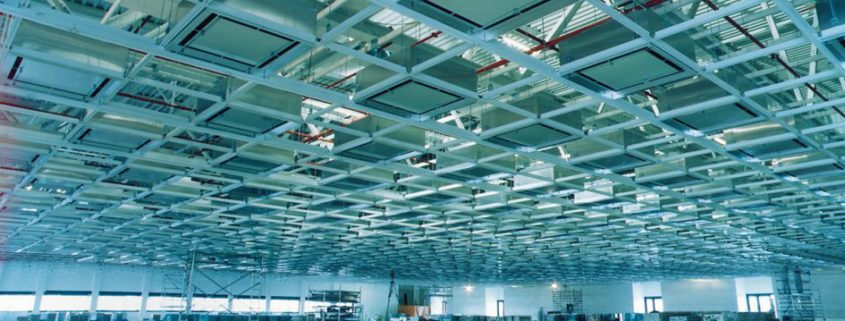Air Filtration and Filtering In Cleanrooms – Part 3
Terminal Filters
These filters are available in two types of constructions: (1) Box type and (2) Flanged type.
1) Box type filters are more suitable for housing within the ceiling slab cutout where removal of filter is from above. Whenever filter removal is not from above e.g. in case of filter being mounted in false ceiling, flanged type of filters is used.
2) With flanged type of filters, additional housing is required to facilitate the mounting of filters and transfer the load to false ceiling members. These housings can also be provided with an alternate arrangement to transfer the filter load to ceiling slab.
Aluminum / stainless steel slotted type protective grilles can be provided under the terminal filters. The housing and grilles should be epoxy/stove enamel painted.
Pre-filters to HEPA Filters
In order to prolong the service life of HEPA filters, pre-filters are recommended to filter out majority of particles above 1 micron. Pre-filters are normally mounted in a separate plenum with an access door after supply air fan discharge at an appropriate location. Normally flanged filters are used for mounting in such plenums.
It should be convenient to clean and replace these filters without disturbing the rest of the filtration system.
Pre-filters are available in various sizes with 6” and 12” thickness and with pressure drop in the range of 0.2” to 0.25” w.c. However, dust holding capacity of these filters is poor. For applications which require a filtration system with good dust holding capacity, bag type filters with fiberglass scrim cloth media are recommended. These can have efficiencies from 85% (down to 20 microns) to 99.97% (down to 5 microns).
For years, a value of 90 fpm (0.46 m/s) ±20% has been used to specify the airflow in the cleanest of cleanrooms. The primary objective is to maintain airflow in parallel flow streams that has two purposes: first, it needs to dilute particle concentrations that may have formed in the room due to personnel or process activity and second, to carry away particles or contaminants generated within the room. Although, higher air velocity is advantageous in particle removal/settlement, this will also result in over sizing of equipment that may be very energy inefficient, leading to higher energy costs.
Set velocity of 90 FPM! Is it Mandatory Requirement?
There is nothing called set velocity; the 90 fpm velocity is just a widely accepted practice. There is no scientific or statutory basis for this guideline. The figure 90 fpm velocity is purely derived from past practices over two decades and has become a common industry practice. In recent years, companies have experimented with lower velocities and have found that airflow velocity specifications ranging from 70 to 100 fpm (0.35 to 0.51 m/s) ± 20% could be successful, depending on the activities and equipment within the room. For example, in an empty room with no obstructions to the airflow, even the air velocities @70 FPM should remove contamination effectively. There is no single value of average velocity or air change rate accepted by the industry for a given clean-room classification. In general, the higher values are used in rooms with a greater level of personnel activity or particle-generating process equipment. The lower value is used in rooms with fewer, more sedentary, personnel and/or equipment with less particle-generating potential.
Airflow based on Air change rate (ACR)
Air change rate is a measure of how quickly the air in an interior space is replaced by outside (or conditioned) air. For example, if the amount of air that enters and exits in one hour equals the total volume of the cleanroom, the space is said to undergo one air change per hour. In addition to air change rate, air flow rate is measured in appropriate units such as cubic feet per minute (CFM) and can be calculated with this formula;
Air flow rate = Air changes x Volume of space/ 60
Air change rate is an indication of the air-tightness of a room, but it is difficult to pin down because it depends significantly on how the room is used, as well as the wind and temperature differentials experienced during the year. Even if the rate were determined with great precision with a blower-door test, there is no assurance the resultant value would apply under different conditions. The air change per hour criterion is most commonly used in cleanrooms of less stringent cleanliness. Intermediate cleanrooms are usually designed with hourly air change rates between 20 and 100, while less stringent cleanrooms have hourly air change rates up to 15. The designer selects a value based on his experience and understanding of the particle-generating potential of the process. This is a highly subjective process, which better than nothing, is not very scientific.
Higher ACR equate to higher airflows and more energy use. In most cleanrooms, human occupants are the primary source of contamination. Once a cleanroom is vacated, lower air changes per hour to maintain cleanliness are possible allowing for setback of the air handling systems. Variable speed drives (VSD) should be used on all recirculation air systems allowing for air flow adjustments to optimize airflow and/or account for filter loading. Where VSD are not already present, they can be added and provide excellent payback if coupled with modest turndowns. The benefits of optimized airflow rates are
1) Reduced Capital Costs – Lower air change rates result in smaller fans, which reduce both the initial investment from construction cost. A 20 percent decrease in ACR will result in close to a 50 percent reduction in fan size.
2) Reduced Energy Consumption – The energy savings opportunities are comparable to the potential fan size reductions. According to the fan affinity laws, the fan power is proportional to the cube of air changes rates or airflow. A reduction in the air change rate by 30% results in a power reduction of approximately 66%. A 50 percent reduction in flow will result in a reduction of power by approximately a factor of eight or 87.5 percent.
Designing a flexible system with variable air flow can achieve the objectives of optimized airflow rates. Existing systems should be adjusted to run at the lower end of the recommend ACR range through careful monitoring of impact on the cleanroom process (es).
Criteria for Selecting Citations and Studies for This Review:
Articles dealing with outbreaks of infection due to environmental opportunistic microorganisms and epidemiological- or laboratory experimental studies were reviewed. Current editions of guidelines and standards from organizations (i.e., American Institute of Architects [AIA], Association for the Advancement of Medical Instrumentation [AAMI], and American Society of Heating, Refrigeration, and Air-Conditioning Engineers [ASHRAE]) were consulted. Relevant regulations from federal agencies (i.e., U.S. Food and Drug Administration [FDA]; U.S. Department of Labor, Occupational Safety and Health Administration [OSHA]; U.S. Environmental Protection Agency [EPA]; and U.S. Department of Justice) were reviewed. Some topics did not have well-designed, prospective studies nor reports of outbreak investigations. Expert opinions and experience were consulted in these instances.



